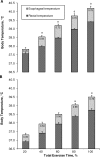Aural canal, esophageal, and rectal temperatures during exertional heat stress and the subsequent recovery period
- PMID: 20210619
- PMCID: PMC2838467
- DOI: 10.4085/1062-6050-45.2.157
Aural canal, esophageal, and rectal temperatures during exertional heat stress and the subsequent recovery period
Abstract
Context: The measurement of body temperature is crucial for the initial diagnosis of exertional heat injury and for monitoring purposes during a subsequent treatment strategy. However, little information is available about how different measurements of body temperature respond during and after exertional heat stress.
Objective: To present the temporal responses of aural canal (T(ac)), esophageal (T(es)), and rectal (T(re)) temperatures during 2 different scenarios (S1, S2) involving exertional heat stress and a subsequent recovery period.
Design: Randomized controlled trial.
Setting: University research laboratory.
Patients or other participants: Twenty-four healthy volunteers, with 12 (5 men, 7 women) participating in S1 and 12 (7 men, 5 women) participating in S2.
Intervention(s): The participants exercised in the heat (42 degrees C, 30% relative humidity) until they reached a 39.5 degrees C cut-off criterion, which was determined by T(re) in S1 and by T(es) in S2. As such, participants attained different levels of hyperthermia (as determined by T(re)) at the end of exercise. Participants in S1 were subsequently immersed in cold water (2 degrees C) until T(re) reached 37.5 degrees C, and participants in S2 recovered in a temperate environment (30 degrees C, 30% relative humidity) for 60 minutes.
Main outcome measure(s): We measured T(ac), T(es), and T(re) throughout both scenarios.
Results: The T(es) (S1 = 40.19 +/- 0.41 degrees C, S2 = 39.50 +/- 0.02 degrees C) was higher at the end of exercise compared with both T(ac) (S1 = 39.74 +/- 0.42 degrees C, S2 = 38.89 +/- 0.32 degrees C) and T(re) (S1 = 39.41 +/- 0.04 degrees C, S2 = 38.74 +/- 0.28 degrees C) (for both comparisons in each scenario, P < .001). Conversely, T(es) (S1 = 36.26 +/- 0.74 degrees C, S2 = 37.36 +/- 0.34 degrees C) and T(ac) (S1 = 36.48 +/- 1.07 degrees C, S2 = 36.97 +/- 0.38 degrees C) were lower compared with T(re) (S1 = 37.54 +/- 0.04 degrees C, S2 = 37.78 +/- 0.31 degrees C) at the end of both scenarios (for both comparisons in each scenario, P < .001).
Conclusions: We found that T(ac), T(es), and T(re) presented different temporal responses during and after both scenarios of exertional heat stress and a subsequent recovery period. Although these results may not have direct practical implications in the field monitoring and treatment of individuals with exertional heat injury, they do quantify the extent to which these body temperature measurements differ in such scenarios.
Figures



Similar articles
-
Cold-water immersion and the treatment of hyperthermia: using 38.6°C as a safe rectal temperature cooling limit.J Athl Train. 2010 Sep-Oct;45(5):439-44. doi: 10.4085/1062-6050-45.5.439. J Athl Train. 2010. PMID: 20831387 Free PMC article. Clinical Trial.
-
Safe cooling limits from exercise-induced hyperthermia.Eur J Appl Physiol. 2006 Mar;96(4):434-45. doi: 10.1007/s00421-005-0063-y. Epub 2005 Dec 3. Eur J Appl Physiol. 2006. PMID: 16341523
-
Influence of circulating cytokines on prolactin during slow vs. fast exertional heat stress followed by active or passive recovery.J Appl Physiol (1985). 2012 Aug 15;113(4):574-83. doi: 10.1152/japplphysiol.00523.2012. Epub 2012 Jun 21. J Appl Physiol (1985). 2012. PMID: 22723625
-
Heat stress and fetal risk. Environmental limits for exercise and passive heat stress during pregnancy: a systematic review with best evidence synthesis.Br J Sports Med. 2019 Jul;53(13):799-805. doi: 10.1136/bjsports-2017-097914. Epub 2018 Mar 1. Br J Sports Med. 2019. PMID: 29496695
-
Does Gender Affect Rectal Temperature Cooling Rates? A Critically Appraised Topic.J Sport Rehabil. 2019 Jul 1;28(5):522-525. doi: 10.1123/jsr.2018-0081. Epub 2018 Oct 11. J Sport Rehabil. 2019. PMID: 29809089 Review.
Cited by
-
Cold-water immersion and the treatment of hyperthermia: using 38.6°C as a safe rectal temperature cooling limit.J Athl Train. 2010 Sep-Oct;45(5):439-44. doi: 10.4085/1062-6050-45.5.439. J Athl Train. 2010. PMID: 20831387 Free PMC article. Clinical Trial.
-
Effects of mild hypohydration on cooling during cold-water immersion following exertional hyperthermia.Eur J Appl Physiol. 2016 Apr;116(4):687-95. doi: 10.1007/s00421-016-3329-7. Epub 2016 Jan 18. Eur J Appl Physiol. 2016. PMID: 26781710
-
Cryotherapy-Induced Persistent Vasoconstriction After Cutaneous Cooling: Hysteresis Between Skin Temperature and Blood Perfusion.J Biomech Eng. 2016 Mar;138(3):4032126. doi: 10.1115/1.4032126. J Biomech Eng. 2016. PMID: 26632263 Free PMC article. Clinical Trial.
-
A Systematic Review of Post-Work Core Temperature Cooling Rates Conferred by Passive Rest.Biology (Basel). 2023 May 9;12(5):695. doi: 10.3390/biology12050695. Biology (Basel). 2023. PMID: 37237510 Free PMC article. Review.
-
Roundtable on Preseason Heat Safety in Secondary School Athletics: Prehospital Care of Patients With Exertional Heat Stroke.J Athl Train. 2021 Apr 21;56(4):372-382. doi: 10.4085/1062-6050-0173.20. J Athl Train. 2021. PMID: 33290540 Free PMC article.
References
-
- Armstrong L. E., Casa D. J., et al. American College of Sports Medicine. American College of Sports Medicine position stand: exertional heat illness during training and competition. Med Sci Sports Exerc. 2007;39(3):556–572. - PubMed
-
- Bonauto D., Anderson R., Rauser E., Burke B. Occupational heat illness in Washington State, 1995–2005. Am J Ind Med. 2007;50(12):940–950. - PubMed
-
- Carter R., III, Cheuvront S. N., Williams J. O., et al. Epidemiology of hospitalizations and deaths from heat illness in soldiers. Med Sci Sports Exerc. 2005;37(8):1338–1344. - PubMed
-
- Casa D. J., McDermott B. P., Lee E. C., Yeargin S. W., Armstrong L. E., Maresh C. M. Cold water immersion: the gold standard for exertional heatstroke treatment. Exerc Sport Sci Rev. 2007;35(3):141–149. - PubMed
Publication types
MeSH terms
LinkOut - more resources
Full Text Sources
Other Literature Sources
Medical
Research Materials

